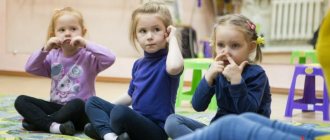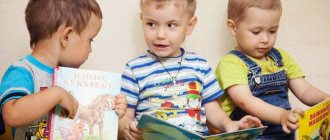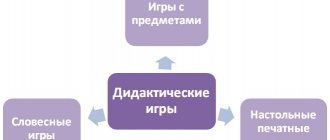Child 5 years old developmental delay
Before the age of 5, specialists may still doubt the accuracy of the diagnosis of mental retardation, observe and only slightly correct development. At the age of 5, there comes a period when confirmation of the diagnosis means the beginning of full-fledged correctional work in both the pedagogical and therapeutic spheres. This is due to the approaching period of schooling, when mental retardation will significantly reduce the quality of learning the material. It becomes obvious to others that there is a lag in the development of speech, logic, and the emotional-volitional sphere. The most striking signs that a child is falling behind his peers are the inability to count to 10, problems remembering the names of shapes and size ratios, and the inability to distinguish colors. Teachers use several techniques when working with children. Among them is the previously mentioned Montessori system, the Zaitsev’s Cubes method. Psychologists use fairy tale therapy, sand activities, and play therapy to work with children with mental retardation.
Child development at 3 years old
As mentioned earlier, 3 years of age often becomes the very period when parents and specialists begin to actively work on psychodiagnosis and correction. The main correctional work is carried out in the field of speech development. The fact is that it is the very first thing that attracts attention. But correction can begin only after a comprehensive examination of the child by a neurologist, ENT doctor, speech therapist, or psychologist. If the commission determines that there are problems, a work plan will be drawn up. As for other areas of mental development, at the age of 3 the child is given regular classes, the same as with all preschoolers of this age.
Program for children with mental retardation
Due to obvious circumstances, children with mental retardation cannot study together with their peers and according to the same program. The sooner a child starts studying according to an adapted program, the sooner he will be able to catch up with his peers. Therefore, it is important to provide a special educational process even during training in the garden. Unlike normally developing children, whose motivation for learning is very high by nature, children with developmental delays most often do not show interest in cognitive activities. This means that the primary task facing teachers and parents is to try to interest the child. In this case, knowledge acquisition occurs during the game. Let us give an example: normally developing children separate educational and play activities; they are able to learn mathematics, reading, and writing together with a teacher, but most often play independently with each other. This is how the comprehensive development of personality occurs. But for children with mental retardation, these types of activities must be combined into one, because the educational activity itself will not arouse interest, and therefore will not lead to success.
The developmental education program, adapted to the characteristics of children with mental retardation, includes several basics. Great importance is given to the development of psychophysical functions, since without them it will be difficult for a child to master schooling. Increased attention is paid to the development of a general outlook and it is built taking into account the characteristics of poor perception. An important part of the program is devoted to overcoming intellectual passivity and the general development of intelligence, since the lag in the development of memory, thinking, and speech significantly reduces it.
Speech development in children with mental retardation
Due to developmental characteristics, children with mental retardation always suffer from speech development. Even if she is able to satisfy superficial needs in daily communication, it is difficult to express her own thoughts or increase her vocabulary. In addition, there are problems in the development of phonemic hearing and pronunciation. In the future, these problems will be supplemented by dysgraphia, dysarthria, and other speech therapy problems. For the best development of speech in children with mental retardation, specialists usually combine speech therapy and therapeutic neurological work. Work is going on in several directions simultaneously. During each lesson, the specialist works on sound pronunciation, improving phonemic hearing, enriching vocabulary, and grammatical structure of speech. The lesson also includes articulation and breathing exercises, finger games.
Classes on speech development must be conducted individually with a constant change of activities and several breaks.
Child development delay treatment
In addition to correctional work, specialists use medication treatment when working with a child with mental retardation. It is carried out under the guidance of a neuropsychiatrist. Medicinal products such as nootropics, vitamin complexes, drugs that improve cerebral circulation, sedatives, or vice versa, psychostimulants, dietary supplements show high effectiveness. Specific treatment is based on symptoms, psychodiagnostic examination, and the patient’s individual history. Drug treatment is accompanied by massage, physical therapy, and therapy with animals.
When combining pedagogical correctional work, drug treatment and preventive procedures, success in eliminating mental retardation occurs in 8 out of 10 children. Moreover, most of them catch up with their peers by the time they reach school.
Working with children with mental retardation
Daily development work is divided into 2 stages. The first is the development of speech, clear pronunciation of words, and the ability to isolate the main points in the teacher’s speech. The greatest effectiveness in speech development can be achieved through the development of fine motor skills. Children are given finger play training, graphic exercises, and sporting events.
The second stage is intellectual development. Particular attention is paid to working with the mental function that is most affected by a child with mental retardation. At the same time, the practical orientation of the material to be studied is always intensified, and reliance is placed on the life experience that the child has already acquired. Initially, individual correctional work is carried out, and gradually children are combined into small groups of 2-4 people.
Child 4 years old developmental delay
If developmental delay is diagnosed in a 4-year-old child, parents will most likely be offered to attend a specialized correctional kindergarten. In this case, the conclusion will mainly be based on the degree of speech development, the ability to play, including the ability to master role-playing games. Specialized programs for children 4 years old are mainly based on the principles of Maria Montessori's methodology. It creates a unique opportunity for a child to learn and play in a way that is convenient for him. At the same time, a specialist working with a child, during the observation process, will be able to determine which areas of mental and personal development need additional attention and will direct the child’s attention to their development.
Delayed development of children at 2 years of age
It is too early to say that a child has developmental delay at 2 years of age. Experts do not prescribe additional medical or psychological-pedagogical examinations if a two-year-old child has not mastered speech or cannot play with a sorter. Some speech therapists take such children to their classes, but this is not a necessity for the child. Rather, this is a way to reassure parents and earn money as a specialist. In reality, at this age it is enough for the child to study with his mother. To do this, you can use books teaching Montessori methods, or even attend developmental classes once a week.
Features of children with mental retardation
Parents first learn that a child has some kind of mental development disorder at about 3-4 years of age. Before this age, it is difficult to judge whether a child is ahead or behind in the development of his peers, since it occurs in waves. Even if just yesterday a friend boasted that her child had learned all the numbers or remembered the names of colors, and your child continued to get confused in them, then tomorrow he can suddenly figure out the shades not only in Russian, but also in English. Upon admission to kindergarten and under the close attention of professional teachers, speech therapist, and psychologist, features can finally be identified. The first corrective developmental work will begin there, based on the results of diagnostics of all areas of mental development.
Among the common features of children with mental retardation, several main ones can be identified:
Firstly, the delay affects the memorization of new information, its assimilation and application. To memorize a simple quatrain, such a child will need more time than his classmates, the words will be confused. The rules of the game have to be constantly reminded, simply because even learned information is quickly lost, and the capacity of long-term memory is significantly limited.
Secondly, memory problems affect the perception of the overall picture of the world and the things surrounding the child. Perception is based mainly on visual representations, so visibility becomes an important operating principle.
Thirdly, attention is greatly affected in children with mental retardation. In principle, it is difficult for preschoolers to do one thing for a long time, to keep their attention on one subject, and when it comes to delays, distractions become even more frequent. Such children need a constant change of activity and a complete absence of distractions. If we are talking about home education, then the computer, TV, and telephone should be completely excluded from the child’s life. Schools and kindergartens require a special learning environment.
Fourthly, figurative and abstract thinking is practically absent or works only with the guidance of an adult, however, like logical thinking. Finding a possible solution to a problem, analyzing the cause of an event and its consequences, analyzing information received in the past - all this is difficult for children with mental retardation.
As for emotions and feelings, ZPR will affect them too. The mood can change sharply and frequently, the child can show aggression, or, on the contrary, be anxious and unsure of himself. The presented picture of the characteristics of children with mental retardation cannot fully characterize a particular child. Each developmental delay is individual: some areas are more affected, others less. Therefore, if suspicion arises, the child must be carefully examined by a whole commission of specialists to draw up the most complete picture.




![Letter L and sound [l]](https://pleshakof.ru/wp-content/uploads/bukva-l-i-zvuk-l-330x140.jpg)



